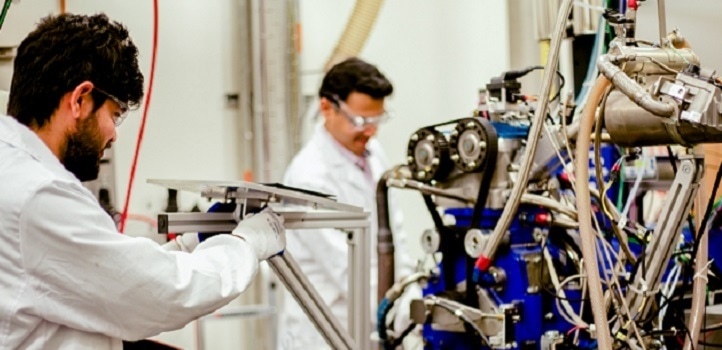Mar 29 2019
Designers of fuel-efficient engines are still plagued by a combustion issue that has troubled engine developers ever since the inception of the industry.
 PhD student Eshan Singh working on the KAUST pre-ignition engine. (Imge credit: 2019 Raheena Abdurehim)
PhD student Eshan Singh working on the KAUST pre-ignition engine. (Imge credit: 2019 Raheena Abdurehim)
Now, researchers at KAUST’s Clean Combustion Research Center, headed by Robert Dibble, are trying to learn more about pre-ignition. A sole occurrence of pre-ignition—which refers to the premature ignition of fuel in the engine cylinder to produce an untimely kick of energy—can cause a considerable amount of damage. Moreover, pre-ignition is both unpredictable and irregular, and it is more common in the compact, turbocharged engines that are being produced by car manufacturers to ensure better fuel efficiency and, at the same time, maintain the power output.
Pre-ignition remains a bottleneck to further downsizing and improving engine efficiency.
Eshan Singh, PhD Student, Clean Combustion Research Center, KAUST
Singh is a PhD student in Dibble’s team.
The researchers methodically modified engine parameters, including exhaust back-pressure and air intake temperature, thereby ascertaining the conditions that are conducive for pre-ignition. For instance, with a higher exhaust back pressure, the researchers noted more pre-ignition events—this happens when the burnt fuel between the combustion cycles does not empty effectively from the engine cylinder.
The investigators integrated all their observations to create a picture of the phenomenon of pre-ignition. “Our work unravels the pre-ignition event is divided into several steps,” stated Singh.
An event of pre-ignition arises during the preceding cycle of fuel combustion, when fuel is injected into the cylinder. This fuel then interacts with oil on the cylinder liner and thus creates an oil-fuel droplet. Towards the end of every combustion cycle, this oil-fuel droplet is normally removed from the cylinder, but, now and then, the droplet remains and can cause pre-ignition in the subsequent cycle, the researchers demonstrated.
“Car makers need to break this chain of events to suppress pre-ignition,” said Singh.
Preventing the interaction between oil and fuel, or fully exhausting the entire burnt mixture from the engine cylinder, are a couple of points which offer the possibility to break the chain of events. One method is to stop the injected fuel from striking the oil-coated cylinder liner.
We are looking at practical methods to reduce pre-ignition by changing the injection strategy. We have filed a patent that uses injection strategies to provide pre-ignition-free operation without compromising engine power.
Eshan Singh, PhD Student, Clean Combustion Research Center, KAUST
Other methods to break the event chain requires greater insight into pre-ignition, Singh added that “Our exciting discoveries are gratifying. Going forward, we are motivated to uncover additional controlling variables that allow for more accurate pre-ignition predictions.”
Singh will graduate from KAUST in the fall of 2019. At present, he is interning at the Combustion Research Facility in Sandia National Laboratories located in California, where he is studying mixed-mode combustion for upcoming internal combustion engines.
This experience has already exposed me to a plethora of tools that are frequently used in engine combustion diagnostics. Several new avenues have now opened for my research career, which is vested in tackling solutions to combat climate change.
Eshan Singh, PhD Student, Clean Combustion Research Center, KAUST